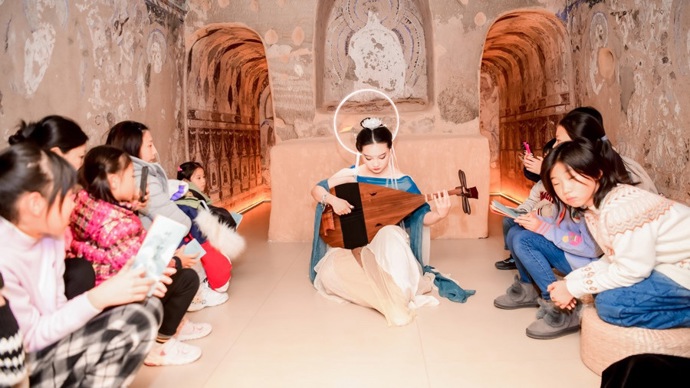Enjoy Pipa in the recarved grottoes Immersive concert in the first professional museum of journalism and publishing in China
The sudden drop in temperature in Shencheng did not stop parent-child families from exploring and feeling the enthusiasm of traditional culture. On the evening of December 16, the China Modern and Modern Press and Publication Museum, located at 3678 Zhoujiazui Road, ushered in a carefully planned parent-child theme concert "Time and Space Printing Painting", which integrates printing culture and traditional music culture.

Why was the pipa chosen to feature in this museum concert? How to make print and music, visual and auditory artfully relate together? The answers are presented to participants in a shuttle through the theme pavilions on each floor of the museum.
The idea for the concert came from the image of a pipa girl on a photocopper-plate in the collection of the China Modern and Contemporary Press and Publication Museum.
Pipa has been inherited for thousands of years, and the image of the pipa has appeared many times in the murals. Poets are keen to express their love for the pipa in the poems and songs. In the pipa music and Gongchi music of Dunhuang, the sound of the pipa has spread continuously, and the "printing" and "painting" have contributed greatly. The pipa players of Shanghai East Palace Art Troupe took the strings as the medium and the music as the guide, bringing the "Tang Pipa", "five-stringed pipa", "Ming and Qing Pipa", "modern pipa" and "electric pipa" to the scene, presenting a journey of sound and painting across time and space for the audience.
The first piece of Yingzhou ancient tune "Yue Er Gao" played on the second floor of the museum, the performer made up to restore the female image of the pipa of the photographic copper plate of the cultural relics in the collection, holding the pipa of the Ming and Qing Dynasties, and the unique ancient sound of the silk string slowly sounded. As early as the Tang Dynasty, there were words such as "combined four feet on the work of six and five" to indicate the pitch, and special characters marked the finger position to mark the score. This track uses the Gongchi score of Yue Er Gao as the main visual element to show the inextricable relationship between music and publishing.
There are also three original pieces with distinctive themes. "Shin Dong Beats West" begins in the printing workshop, where the players play a rumbling metal melody next to the sleeping old printing machinery. In the "Yao" sounded in the Qiuci caves, the two players played the "sun" and "moon", and the Tang lute and the five-string lute sounded like the sun and the moon, reflecting the situation in the murals. "Time and Space Printing Painting" is played in a digital publishing hall full of science and technology. The electric pipa opens with a sound. Technology and culture collide and intertwine, drawing a beautiful time and space printing painting.
The time and space collision between intangible music and modern publishing is the Yingzhou ancient melody inheriting in Gongchi ancient music, the anonymous pipa Qinji left on the photographic copper plate, the modern publishing melody played in the mechanical clang, the music and dance flying through the millennium in Qiuzi Grottoes, and the beautiful fantasy of the collision between scientific and technological currents and ancient music culture. The activity divides each floor of the venue into time and space. The cultural relics in the museum have been carefully excavated, which can be called a "tailor-made" traditional cultural journey.
The museum staff introduced to the participants a special exhibition on the digital restoration of caves on the third floor, which restored the domes of caves 38 and 17 of Kizil Grottoes and Kumtula Grottoes in Xinjiang. Among them, 38 grottoes have the reputation of musicians' chorus grottoes. The Musical Instruments appearing in the murals of Tiangong Chi Music include transverse flute, Ruan Xian, Konghou, pipa, Tartar pipe, brass cymbals, pan flute and wax drum, which witness the history of the fusion of Silk Road music and dance art in ancient Qiuzi. The cave itself has a natural reverberation effect, in which the audience sits on the floor, enough to feel the dialogue through time and space.
The activity also designed an interactive game session. In the printing Technology Museum on the third floor, the photo copper plate with the image of a pipa woman can be found, and the museum's exclusive seal can be obtained. The audience can find the "golden Pipa" pattern of colorful stone printing in the teaching book after turning the plate, and also get a New Year gift with pipa elements. At the performance site, parents and children explored the mystery of treasure hunting, looking for the internal connection between traditional printing and modern digital life in the light and shadow flow. Everyone is immersed in the beauty of the sound and painting art brought by the non-heritage pipa, and they are not enough to linger.
The "Time and Space Printing and Painting" immersive parent-child theme concert (Pipa special concert) was organized by China Modern and Contemporary Press and Publication Museum, Shanghai Research Center for Caring for the Next Generation, co-organized by Hudong Workers' Cultural Palace, and hosted by China Welfare Association Children's Education and Media Center. It adopts the form of immersive concert, aiming to let young people have "resonance" and "empathy" for excellent traditional Chinese culture. Let the intangible cultural heritage and red culture, Shanghai culture and Jiangnan culture interconnect and integrate, through the new forms of teaching and entertainment, parent-child interaction, stage performance and other diversified forms, to help young people understand and participate in the inheritance of excellent traditional Chinese culture. The series of performances is planned to continue in different solar terms in 2024, bringing visual and spiritual enjoyment to audiences of all sizes who love traditional culture, and creating a window to showcase Chinese culture.
 渝公网安备 50010702504639号
渝公网安备 50010702504639号